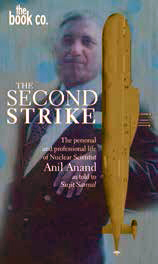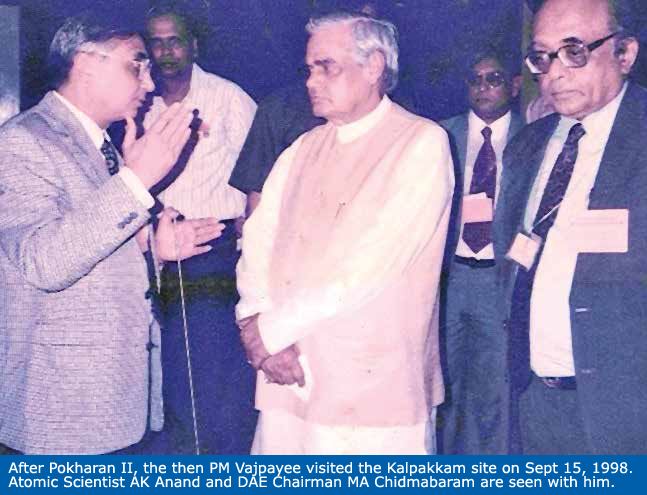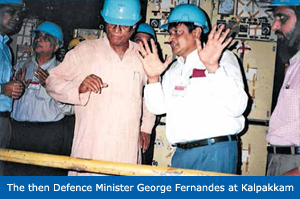| “I
am delighted to learn that the nuclear propulsion reactor on board INS Arihant,
India’s first indigenous nuclear powered submarine, has now achieved criticality.
I extend my congratulations to all those associated with this important milestone,
particularly the Department of Atomic Energy (DAE), the Indian Navy and the Defence
Research and Development Organisation (DRDO). Today’s development represents a
giant stride in the progress of our indigenous technological capabilities. It
is a testimony to the ability of our scientists, technologists and defence personnel
to work together for mastering complex technologies in the service of our nation’s
security.” This seminal achievement got eclipsed by the media coverage
of the reverberations of the unfortunate explosion and sinking of the Kilo class
submarine INS Sindhurakshak with 18 deaths in the Naval Dockyard at Mumbai four
days later on the August 14 night. Submarine operations call for high safety standards
and quality control checks, as failure of a small system or component or a pump
can cause heavy costs and damages. Each crew member has to be an all round professional,
and physiologically suited for underwater service and hardships, especially in
nuclear submarines. In USA, Admiral Hyman D. Rickover, known as the father of
nuclear submarines, interviewed every officer and sailor personally for service
in nuclear boats, and even rejected Lt Cdr Elmo Zumwalt Jr (Bud) who later became
US Navy’s 19th and the youngest Chief of Naval Operations (CNO). British
science fiction writer Sir Arthur Clark, known for co-writing in the 1960s the
script for futuristic 2001: A Space Odyssey film and for first proposing connectivity
through satellites and computers once said, “Any sufficiently advanced technology
is indistinguishable from magic.” The statement well applies to miniature nuclear
reactors which enable men (and now women) in submarines to safely and comfortably
live and operate underwater for months before surfacing. Oxygen is regenerated
from sea water. The advantage of a nuclear submarine over conventional submarines
is that she can propel underwater for months, the limitation being onboard food
supply and human endurance. In the US Navy, which operates nuclear submarines
worldwide, crews operate till about three months. There are however two sets of
crews, gold and blue, to man and maintain the submarine alternately. A
nuclear submarine is Pearl shaped, with faster speed underwater than on surface.
Inertial navigation gadgets, underwater receivers and sonars ensure her safe navigation
and communications. Coded Signals Coded signals
to launch missiles or weapons can be sent to a submarine from the nation’s political
nuclear command authority. In India, the Government’s decision for nuclear action
will be conveyed through the National Security Adviser (NSA) as extracted from
the Prime Minster’s black attaché case of codes, held also by the submarine’s
Captain. The extra low frequencies (ELF) signals are received through trailing
antennas, or Blue-Green lasers that can penetrate the sea, or some other secret
means. In India’s case, there are some secret locations for this and one new one
on the southern coast, called INS Katabomman. Incidentally in USA, the
President’s code box is called the Football, and is always in his easy reach.
Nuclear weapons are strategic weapons to deter an attack or to destroy the adversary
in case of attack. Indigenous capability is vital in setting up what is called
the nuclear triad. A Real ‘Make in India’ Project
It is to the credit of the Indian Navy planners that they realised this and joined
hands with scientists at Bhabha Atomic Research Centre (BARC) as early as the
1980s when naval officers were deputed to BARC’s Atomic Training Centre. Jointly,
they began designing miniature nuclear reactors in a classified group code-named
the new New Reactor Projects Division, carved out of BARC’s Reactor Engineering
Division, with dozens of engineers as the core design team. Work under Dr RP Dastidar,
head of the Reactor Group, had already begun and was code-named PRP (Propulsion
Recycling Project – land Based) in the late 1970s, after the confidence gained
in the Smiling Buddha Peaceful Nuclear Explosion (PNE) test on May 18, 1974. The
US had sent its Enterprise aircraft carrier to support Pakistan during the 1971
Bangladesh Liberation War, prompting India to sign a Treaty of Friendship with
the erstwhile Soviet Union. Moscow sent a nuclear submarine to the Bay of Bengal.
The then Prime Minister, Mrs Indira Gandhi, realised the importance of nuclear
submarines and decided to build this capability indigenously. The nuclear
and space programmes are controlled directly by the Prime Minister’s Office; it took
time nonetheless due to the political dynamics of the country. Finally, in 1983, she gave
her blessings, and funds, to the PRP project and entrusted its execution to Department
of Atomic Energy (DAE) Chairman Dr HN Sethna and BARC Director Dr Raja Ramanna,
who directed the 1974 PNE test.  The
team included Messrs VK Mehra, RB Grover, RS Yadav and S Basu - the current head
of BARC - under US and France trained atomic scientist Dr Anil K Anand. In his just
published autobiography Second Strike, Dr Anand has included some details of the
work by the New Reactor Projects Division; he was a colleague of Dr Anil Kakodkar
at BARC. Over the years, Prime Ministers Rajiv Gandhi and AB Vajpayee and Defence
Minister George Fernandes lent full support to the project. The
team included Messrs VK Mehra, RB Grover, RS Yadav and S Basu - the current head
of BARC - under US and France trained atomic scientist Dr Anil K Anand. In his just
published autobiography Second Strike, Dr Anand has included some details of the
work by the New Reactor Projects Division; he was a colleague of Dr Anil Kakodkar
at BARC. Over the years, Prime Ministers Rajiv Gandhi and AB Vajpayee and Defence
Minister George Fernandes lent full support to the project.
The Half Submarine Dr Anand studied zircaloy joints and tubes and calandria
ends in France’s Pressure Water Reactors (PWR) at the Centre Energy Atomique at
Scalay near Paris in Section des Advances, for the French EL-4 PWR reactor at
Brennilis and learnt the techniques that helped him at BARC. Dr Homi Bhabha, Chairman
of India’s Atomic Energy Commission (AEC), was keen for this technology, and the
PRP model was used later to build the land based half training nuclear submarine
under the classified Advanced technology Vehicle (ATV) Project. Dr Anand’s knowledge
was useful. Dr Anand relates he was interviewed by late Dr Vikarm Sarabhai
for the BARC job and he recalls meeting Dr Homi Bhabha. The near culmination
of the submarine project – India’s first nuclear powered nuclear armed submarine
Arihant (SSBN) is just about to go for sea trials – is a handsome tribute to the
naval planners, atomic scientists, designers and builders. It has taken long but
the fact that the submarine project, which includes the vessels, their reactors,
some sophisticated onboard systems and nuclear-tipped missiles are just about
ready, is a landmark achievement. 
Arihant
Getting Ready for Sea Trials INS Arihant, the lead vessel in the series,
will sail under the Indian Naval Ensign. There are some checks and rechecks before
she sets for the sea, and some time in 2015 or so, she will become the third leg
of India’s Triad for nuclear deterrence from the sea, when it will be equipped
with DRDO’s underwater SAGARIKA B-05 missile system. Gradually, the range of her
missiles will be increased from about 750 to more than 3000 km. Notably,
the current DRDO Chief, Dr Avinash Chander, recently told India
Strategic that onboard systems and missiles were ready and that their
integration would be done as required. The power of the submarine has steadily
and gradually been stepped up to check her various systems. Arihant has already
cleared all the harbour trials. Project Challenges
In his book, Dr Anand also mentions his hot love affair in France with an affluent
divorcee medical doctor whom he calls Ma Dame (Meera). She was in France from
Thailand on a scholarship, and the two lived together in a hotel in the romantic
Paris. Later they married, although she was many years his senior. The
BARC team under Dr Anand designed and built the half submarine with a miniature
reactor (S-1) for training at the Indira Gandhi Centre for Atomic Research (IGCAR)
at Kalpakkam. This went critical on November 11, 2003 and operational on September 22,
2006. Its replica is the Arihant’s 80 MW pressured Uranium, U-235 light water
reactor. U-235 is enriched uranium. Arihant has been designated S-2 while
the second submarine in the class, Aridhaman, which is also under construction,
is designated S-3.  Dates
of project execution are detailed in the book. The challenge ashore was to make
a dynamo meter to absorb the power which is used in a submarine to power the propeller.
No nation easily shares these details and nuclear technologies. The fuel rods
and pellets for the reactor and cladding were engineered by Dr Anand from imported
Uranium (from Russia) and Indian oxides. Marine reactors are peaceful nuclear
facilities, and outside IAEA safeguards. The over Rs 8,000 crore (Approx $ 5 billion
over the years) ATV project – as it was dubbed in 1983 – was initiated by late
Dr Raja Ramana (PhD in Western music and PhD in Atomic Science, both from UK)
with Mrs Gandhi’s encouragement. She tasked the Navy and DRDO to join hands with
BARC’S PRP project, and Moscow was approached for help. Dates
of project execution are detailed in the book. The challenge ashore was to make
a dynamo meter to absorb the power which is used in a submarine to power the propeller.
No nation easily shares these details and nuclear technologies. The fuel rods
and pellets for the reactor and cladding were engineered by Dr Anand from imported
Uranium (from Russia) and Indian oxides. Marine reactors are peaceful nuclear
facilities, and outside IAEA safeguards. The over Rs 8,000 crore (Approx $ 5 billion
over the years) ATV project – as it was dubbed in 1983 – was initiated by late
Dr Raja Ramana (PhD in Western music and PhD in Atomic Science, both from UK)
with Mrs Gandhi’s encouragement. She tasked the Navy and DRDO to join hands with
BARC’S PRP project, and Moscow was approached for help.
The veil of secrecy
over the ATV project was first lifted on July 26, 2009 when Mrs Gursharan Kaur,
wife of then Prime Minister Dr Manmohan Singh, ceremoniously unveiled the submarine
to the invited guests and media at the Ship Building Centre (SBC), Vishakapatnam,
by breaking the customary coconut to name and bless all those who sail in her
as INS Arihant. Arihant was floated out of the dry dock and berthed alongside.
No photography or visit to the 6,000 tonne black menacing hull was allowed. In his
speech on the occasion, Dr Manmohan Singh thanked all those who had contributed
to the project, including the Russian technicians in the presence of the Russian
Ambassador Alexander Kadakin. It is an engineering feat to master light
water miniature uranium reactors in confined submarine spaces. Only USA, Russia,
France, China and UK with US help have the capability to engineer and manufacture
submarines with nuclear reactors and underwater launched nuclear tipped missiles.
Dr Anand reveals that Arihant was assembled and outfitted at the SBC with
indigenous and imported equipment in a unique Public Private Partnership (PPP)
between BARC, Navy and DRDO with engineering giant Larsen & Toubro (L&T) in a
leased shed and dry dock in the segregated part of the large Naval Dockyard in
Vishakhapatnam. The dockyard was in fact built with Soviet help in the
1970s. Soviet Navy Chief Admiral Sergie Gorshkov however regarded the base as
unsuitable because of the narrow mouth of the port. He also foresaw future congestion,
and offered to build a green-field naval dockyard at Bimplipatam but Mrs Gandhi
did not agree, fearing that Soviets would demand basing facilities. (She had kept
India away from joining any blocs in the east-west Cold War). Incidentally, the
Navy is now building a new green field base, INS Varsha, in the vicinity for exactly
the same reasons. Admiral Gorshkov helped later in leasing nuclear powered
INS Chakra to India in 1987 for training Indian naval personnel in operating n-boats.
He personally reposed faith in Indian Navy officers and sailors in operating the
nuclear submarines. The Navy set up a Machinery Test Centre (MTC) at Vishakapatnam
and the Defence Machinery & Design Establishment at Hyderabad ((DMDE) to pre-test
ATV’s components. The 6,000 tonne submarine houses the computer controlled
and homebuilt reactor, which produces steam under pressure to run the single multiple
bladed propeller and generators to power equipment from inside the sealed nuclear
pressure vessel. The reactor began purring at low power but gradually, it has
been increased and operational and safety checks and rechecks done. Russian
Assistance Russian technicians and Indo-Soviet/ Russian Working Groups
have helped the Arihant programme. An Indian naval submarine design group (SDG)
which was set up initially for the ATV at Kalpakkam, has given valuable support.
The Indian Government has given due credit to Moscow. Project
History It may be recalled that initially, the public sector Mazagon Dock
Ltd (MDL) was keen for the project to be set up in Mangalore on India’s west coast.
But naval planners and BARC scientists, who wanted L&T on board, convinced the
Ministry of Defence (MoD) in favour of Vishakhapatnam, as nuclear facilities with
expertise were available at nearby Kalpakkam. There was also some submarine skill
available in Vishakhapatnam at the Hindustan Shipyard Ltd and naval dockyard where
medium refit of Foxtrot class submarines was done. The Bharat Heavy Plates & Vessels
(BHPV), Bharat Heavy Electricals Ltd (BHEL) Tiruchy, Electronics Corporation of
India Ltd (ECIL) and Bharat Electronics Ltd (BEL), other public sector companies,
were also close by, and involved. Tata Power supplied the weapon control console
while some pumps were imported and some procured indigenously. In the PMO,
the ATV project was under the stewardship of the Scientific Adviser to the Minister
of Defence (SA/MOD) and DRDO head, with naval Project Directors with autonomous
powers. Rear Admirals R S Chaudhry trained at IIT Kharagpur, Greenwich and with
HDW Germany as the naval architect, engineers Gurmeet Singh and N Nadaph, both
trained at BARC, find mention as the naval pioneers who were associated with the
project from Day One. The Project Directors and later Directors General
of the ATV projects were Vice Admirals including the late MK (Mickey) Roy, an
illustrious French trained Alize Observer from 1984 who was also Dr Rammana’s
friend and paying guest roommate in London, followed by Bharat Bhushan till 2000
a UK trained engineering specialist; RN Ganesh, the first Captain of INS Chakra
trained at Vladivostok till 2003; Promod Bhasin, a missile specialist electrical
officer who had served in UK and Soviet Union and prepared the Styx P-20 missiles
for the 1971 war; DSP Verma, and currently; Dinesh Prabhakar. It was Vice
Admiral Bhasin who had the honour to cut steel as Project Director in 1999 on his
birthday with the then Navy Chief Admiral Vishnu Bhagwat’s support, who took great
interest and visited the project. It is pertinent to record that USS Nautilus
took 16 years from 1944 when it was authorised in 1955 for sea trials and in 1960
to join the fleet, while Russia took 16 years to build its first second generation
SSN-093 submarine (1990- 2006). The Arihant achievement must be judged as such,
and lauded. The Indian Navy and the nation look forward to the Red Letter Day
when the Captain can proudly report to the President, India’s Supreme Commander,
‘Arihant is at sea under nuclear power, Sir’, as US Navy’s first submarine Captain
of USS Nautilus did in 1954 and went on to sail under the North Pole undetected. Commodore
Rai is a former Director Naval Intelligence (DNI). |